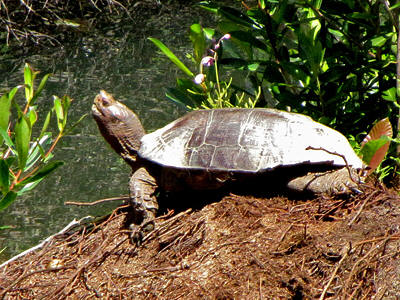 |
Family : GEOEMYDIDAE
Species : Heosemys grandis
Maximum carapace length : 48 cm
The Giant Leaf Terrapin
(or 'Giant Asian Pond Turtle') inhabits standing water bodies such as ponds,
lakes and slow-flowing pools in freshwater swamp forest.
It prefers shallow water, and spends much time soaking in the margins.
When out of the water it generally remains hidden amongst vegetation, but on
occasions may be spotted basking in the sun on open ground.
The species is mainly herbivorous, but will also feed opportunistically on
freshwater invertebrates and fishes.
The carapace is light to medium brown in adults. In younger turtles individual scales are often
yellowish brown in the centre and darker brown at the margin.
There is a pale vertebral keel in both juveniles and adults.
The head is robust and orange-brown in colour, and the snout is blunt : the sides of the head and neck are
mottled.
The posterior marginal scales (i.e. the scales at the edge of the carapace
towards the rear of the shell) are serrated, in the same manner as adults of
the closely-related Spiny Terrapin.
This relatively large turtle, the carapace of which is up to 48 cm long, is commonly reared in captive or ornamental ponds including those
inside Buddhist temples : escapees and introduced populations are thus
common.
Native populations of this species occur in Myanmar, Thailand, Cambodia, Vietnam, Laos and parts of northern Peninsular
Malaysia. In Singapore the species is introduced, though there are no
breeding records in the wild.
Fig 1 :
Giant Leaf Terrapin basking in the morning sun at a flooded and
degraded freshwater swamp forest at Ulu Sembawang, Singapore.
Fig 2 :
Habitat at Ulu Sembawang, Singapore comprising flooded and
degraded freshwater swamp forest with numerous treefalls.
Photos thanks to Tony O'Dempsey
References :
Das, I., 2010. A Field Guide to the Reptiles of South-east Asia. New Holland Publishers (UK) Ltd.
|